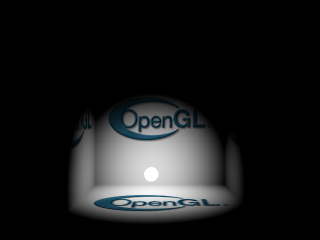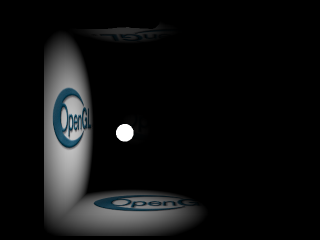Per Pixel Attenuation


Description:
This program displays a cube consisting simply of six quads. A light, using per-pixel attenuation, bounces inside the cube. The attenuation is calculated in four ways.
For the first three methods, the attenuation equation used is:
Attenuation=1-(d^2)/(r^2)
where:
| d | is the distance from the point to the light |
| r | is the light's radius |
The fourth method uses a Gaussian equation:
Attenuation=exp(-k*d^2)
Method 1
This is the method used by my "Per Pixel Lighting" project. It uses two textures storing the attenuation values, and computes 1-(Tex1+Tex2) in the register combiners.
Advantages: Relatively low hardware requirements
Disadvantages: 2 texture units used
Method 2
Using PASS_THROUGH_NV, part of NV_texture_shader, allows the texture coordinates passed to a texture unit to be interpolated, clamped to [0,1] and made available to the register combiners. The attenuation function is then calculated in the combiners.
Advantages: No textures used, Only 1 TMU used, Fastest method
Disadvantages: Nvidia specific
Method 3
This method is much like method 1, but uses a 3d texture instead of 2 textures. This saves a TMU.
Advantages: Only 1 TMU used
Disadvantages: Requires 3d texture support
Method 4
Gaussian attenuation is implemented similarly to method 1. It uses two textures to compute the attenuation, but using a simpler equation. The Gaussian function is separable by multiplication rather than by addition, so all that is needed to calculate it is a simple modulation of two textures. In this demo, this is done with register combiners for similarity to the other methods, but this can easily be calculated without.
Advantages: Low hardware requirements (only multitexture required)
Disadvantages: Uses 2 texture units
Requirements:
EXT_texture_edge_clamp
ARB_multitexture with at least 3 texture units
NV_vertex_program
NV_register_combiners
Recommended:
EXT_texture3D
NV_texture_shader
References:
Texture Compositing with Register Combiners, by John Spitzer. http://developer.nvidia.com
Real-Time Per-Pixel Point Lights and Spot Lights, by Ron Frazier. http://www.ronfrazier.net/apparition
Gaussian Attenuation, by Ignacio Castano. http://talika.eii.us.es/~titan/articles/
